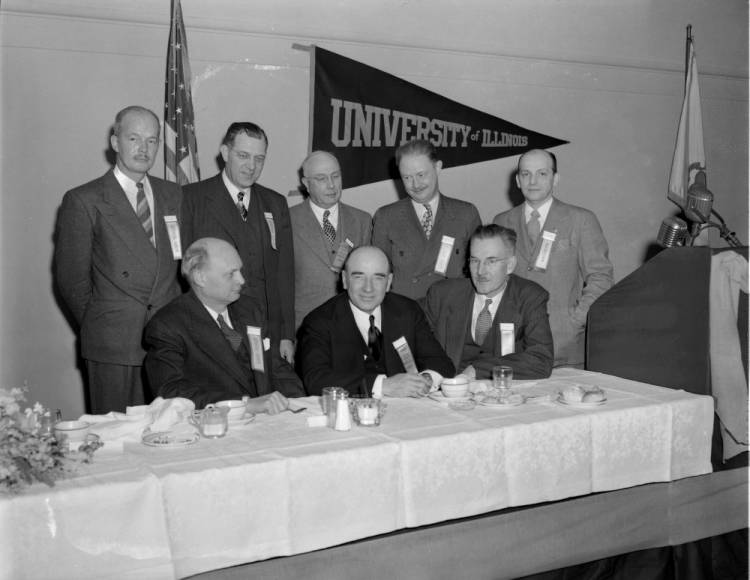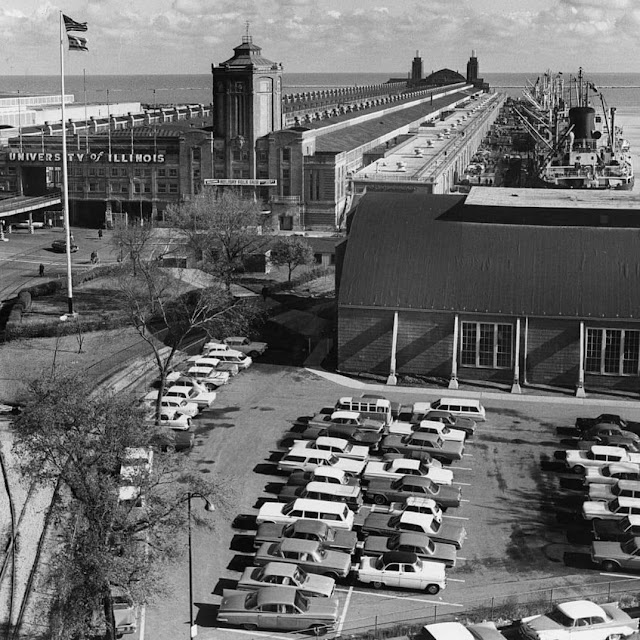Report of the University Committee on a Four-Year Program for the Chicago Undergraduate Division
By Emily Howard – Dec. 4th, 2024

First: What is the Chicago Undergraduate Division?
The Chicago Undergraduate Division was a branch of the University of Illinois that was located at Navy Pier. It provided courses for the first two years of a degree, and then students would have to either transfer to a pricey private college, or to the main campus at Champaign-Urbana.
During its first fall term in 1946, the campus had more than 4,000 students. Students at Navy Pier quickly began to see themselves as separate from the main University of Illinois campus, due to not only the great distance between the campuses but also with the creation of their own intercollegiate sports teams – including basketball, volleyball, badminton, gymnastics and wrestling.
They even had their own mascot, furthering the Navy Pier campus’s independence.


Why Did They Want to Expand?
The President of the University, George D. Stoddard, had a great ambition for the University of Illinois when he was elected in 1946 – wanting to expand the main campus to become a “world-class research institution” and for CUD to become an “applied arts and science institution.”
Originally, he wanted to focus on the expansion of the University of Illinois Medical Center – which would later become part of UIC’s campus in 1982 – into a larger four-year campus. However, the students and faculty at CUD refused to be pushed aside.
“The enrollment has not increased beyond [4,310] because of the lack of adequate facilities at Navy Pier. It is the opinion of the Committee that the two-year program in Chicago would have had a very much larger enrollment had the Division been located on a more appropriate campus”
-pg 7 of the Report
Many of the students at CUD were working while attending university – commonly at the railroads or other local establishments, something that the area around the Champaign-Urbana campus severely lacked – and transferring to the main campus meant having to take a leave of absence from their jobs. They called for a closer campus that would allow working-class students to support themselves while learning.
Not only that, but the CUD campus continued to rise in popularity even after the initial boom of WWII veterans taking advantage of the GI Bill had worn off for other temporary campuses.
There had been a second branch of the University of Illinois at Galesburg – opened at the same time as CUD at Navy Pier – that closed down in 1949 and whose students mostly transferred to the Navy Pier campus, causing severe overcrowding.
In 1954, a survey was done of the current and potential future students that showed that expanding the campus would be beneficial.
So, What Does This Source Mean?
This source was a call to action, stressing the need for – and exact planning of – an expansion of the offered curriculum and for a permanent campus that would be more accessible than Champaign-Urbana.
It references the 1951 General Assembly where the Board of Trustees of the University of Illinois considered – and originally denied – the expansion of CUD, and the 1954 Assembly where they finally agreed to take seriously the need for a “metropolitan” campus in the city of Chicago.


This had been a long fight for the faculty and students of CUD who had been demanding a permanent university, even starting a student organization in 1952 called the “Quad Council” that formed to pressure the Illinois General Assembly board with a “mile-long petition.”
It then documents that in 1957, the Board of Trustees agreed to provide financial support for the acquisition for land and the constructions of buildings for a permanent division of the University of Illinois in Cook County. The document also provides estimations of the college-age population in Chicago for future years and how the current university campuses, not just the University of Illinois, would continue to be inadequate.
Why Does This Matter?
This document shows how the students and faculty at the Chicago Undergraduate Division continued to push for a more permanent campus in the city, even when initially denied. While they didn’t know yet where exactly this campus would go, or the devastation that it would wreck on the Near West Side community, the arguments that they made here – and the assembly meetings that are briefly transcribed – are undeniably a key factor in the creation of the UIC campus on Harrison-Halsted.

The committee went into exacting detail on what curriculum they thought was necessary and what should be left to other campuses. It is interesting to note how some of these courses – such as law – are now a part of UIC, but there are also cases where their suggestions are still followed; for example, UIC only offers a pre-veterinary course before students must enter into the veterinary school at the University of Illinois.
It is clear from their estimates that the faculty who wrote this document were expecting an extraordinary large growth in student enrollments at the permanent campus location, but one has to wonder if they truly understood the extent of the land that the University of Illinois at Congress Circle campus – the prelude to UIC that was first built on the Harrison-Halsted site – would encompass.
At the end of the document there is a timeline planned out, encouraging the site to be chosen by 1959-61, and for the campus to be ready to accept students by 1963.
In actuality, the University of Illinois at Congress Circle campus wouldn’t be ready to accept students until 1965, after much protest from the Harrison-Halsted community in 1963, before the Near West Side was demolished.
Sources
Grossman, Ron. 2016. “University of Illinois at Navy Pier Opened in 1946 to Serve WWII Veterans.” Chicago Tribune. July 8, 2016.
Harr, Sharon “Chapter 4: Classroom off the Expressway: A New Mission for Higher Education”
“History of the University of Illinois at Chicago.” 2024. Archive.org. 2024. https://web.archive.org/web/20120804045340/http://www.uic.edu/depts/uichistory/navypier2.html ; https://web.archive.org/web/20120803003547/http://www.uic.edu/depts/uichistory/gibill.html
Primary Source Citation:
Report of the University Committee on a Four-Year Program for the Chicago Undergraduate Division. Urbana, Illinois, Facility Information Management, UIC Library Digital Collections, https://n2t.net/ark:/81984/d3t14tv83